Red Noise Suppression in Pulsar Timing Array Data Using Adaptive Splines
Abstract
1. Introduction
2. Methods
- Uniform Sampling and Initial Estimation: For each pulsar, the irregularly sampled timing residuals are initially converted into a uniformly sampled sequence via interpolation based on their observation epochs. This uniform sequence is then processed using the SHAPES algorithm to obtain a preliminary estimate of the residuals.
- Reversion to Original Cadence: The estimates generated by SHAPES on the uniform grid are interpolated back to the original, non-uniform observation epochs of each pulsar. This step yields estimates that align precisely with the original data points.
- Low-Pass Filtering: The resulting SHAPES estimates is low-pass filtered to isolate the low-frequency noise components. This is accomplished using a zero-phase digital filter implemented with the filtfilt function in MATLAB, which ensures that the filtering process introduces no phase distortion. A cutoff frequency of Hz is utilized. The order of the filter is determined for each pulsar separately by the formula , where is the number of data points and the hyperparameter is introduced to satisfy the minimum data length requirement of the filter. An optimal value of was selected empirically for this study.
- Noise Subtraction: In the final step, the low-pass filtered SHAPES estimates, representing the extracted red noise, are subtracted from the original timing residuals.
3. Results
- Within the observation duration for each pulsar as given in its par file, create a sequence of regularly spaced observation epochs with 14 days cadence. This is followed by the addition of a 3-day random shift to each epoch to form a sequence of irregularly sampled epochs. The random shift is drawn from an uniform distribution.
- Using PINT, a noise realization for each pulsar is generated using its irregularly spaced sequence of observation epochs. For this, we set the timing uncertainty (i.e., the white noise standard deviation) for all pulsars to 100 ns, and set the intrinsic red noise PSD according to each pulsar’s par file.
- A CW signal, as described below, is injected into the simulated noise.
4. Conclusions
Author Contributions
Funding
Data Availability Statement
Acknowledgments
Conflicts of Interest
Abbreviations
| PTA | Pulsar Timing Array |
| CW | Continuous Wave |
| GWB | Gravitational Wave Background |
| HD | Hellings-Downs Curve |
| SMBHB | Supermassive Black Hole Binaries |
| MSP | Millisecond Pulsar |
| PTMCMC | Parallel Tempering Markov Chain Monte Carlo |
| PSD | Power Spectral Density |
| SHAPES | Swarm Heuristics-based Adaptive and Penalized Estimation of Splines |
| NANOGrav | North American Nanohertz Observatory for Gravitational Waves |
| PPTA | Parkes Pulsar Timing Array |
| EPTA | European Pulsar Timing Array |
| InPTA | India Pulsar Timing Array |
| MPTA | MeerTime Pulsar Timing Array |
| CPTA | Chinese Pulsar Timing Array |
| SNR | Signal-to-Noise Ratio |
| SSB | Solar System Barycenter |
| LSP | Lomb–Scargle Periodogram |
| AIC | Akaike Information Criterion |
References
- Burke-Spolaor, S.; Taylor, S.R.; Charisi, M.; Dolch, T.; Hazboun, J.S.; Holgado, A.M.; Kelley, L.Z.; Lazio, T.J.W.; Madison, D.R.; McMann, N.; et al. The Astrophysics of Nanohertz Gravitational Waves. Astron. Astrophys. Rev. 2019, 27, 5. [Google Scholar] [CrossRef]
- Demorest, P.B. Measuring the Gravitational Wave Background Using Precision Pulsar Timing. Ph.D. Thesis, University of California, Berkeley, CA, USA, 2007. [Google Scholar]
- Lyne, A.; Graham-Smith, F. Pulsar Astronomy, 4th ed.; Cambridge Astrophysics, Cambridge University Press: Cambridge, UK, 2012. [Google Scholar]
- Agazie, G.; Anumarlapudi, A.; Archibald, A.M.; Arzoumanian, Z.; Baker, P.T.; Bécsy, B.; Blecha, L.; Brazier, A.; Brook, P.R.; Burke-Spolaor, S.; et al. The NANOGrav 15 Yr Data Set: Detector Characterization and Noise Budget. Astrophys. J. Lett. 2023, 951, L10. [Google Scholar] [CrossRef]
- Hellings, R.W.; Downs, G.S. Upper Limits on the Isotropic Gravitational Radiation Background from Pulsar Timing Analysis. Astrophys. J. 1983, 265, L39. [Google Scholar] [CrossRef]
- Allen, B. Variance of the Hellings-Downs Correlation. Phys. Rev. D 2023, 107, 043018. [Google Scholar] [CrossRef]
- Allen, B.; Romano, J.D. Hellings and Downs Correlation of an Arbitrary Set of Pulsars. Phys. Rev. D 2023, 108, 043026. [Google Scholar] [CrossRef]
- Allen, B.; Romano, J.D. Optimal Reconstruction of the Hellings and Downs Correlation. Phys. Rev. Lett. 2025, 134, 031401. [Google Scholar] [CrossRef]
- Arzoumanian, Z.; Baker, P.T.; Blumer, H.; Bécsy, B.; Brazier, A.; Brook, P.R.; Burke-Spolaor, S.; Chatterjee, S.; Chen, S.; Cordes, J.M.; et al. The NANOGrav 12.5 Yr Data Set: Search for an Isotropic Stochastic Gravitational-wave Background. Astrophys. J. Lett. 2020, 905, L34. [Google Scholar] [CrossRef]
- Agazie, G.; Anumarlapudi, A.; Archibald, A.M.; Arzoumanian, Z.; Baker, P.T.; Bécsy, B.; Blecha, L.; Brazier, A.; Brook, P.R.; Burke-Spolaor, S.; et al. The NANOGrav 15-Year Data Set: Search for Anisotropy in the Gravitational-Wave Background. arXiv 2023, arXiv:2306.16221. [Google Scholar] [CrossRef]
- Goncharov, B.; Shannon, R.M.; Reardon, D.J.; Hobbs, G.; Zic, A.; Bailes, M.; Curylo, M.; Dai, S.; Kerr, M.; Lower, M.E.; et al. On the Evidence for a Common-spectrum Process in the Search for the Nanohertz Gravitational-wave Background with the Parkes Pulsar Timing Array. Astrophys. J. Lett. 2021, 917, L19. [Google Scholar] [CrossRef]
- Antoniadis, J.; Arumugam, P.; Arumugam, S.; Babak, S.; Bagchi, M.; Nielsen, A.S.B.; Bassa, C.G.; Bathula, A.; Berthereau, A.; Bonetti, M.; et al. The Second Data Release from the European Pulsar Timing Array—III. Search for Gravitational Wave Signals. Astron. Astrophys. 2023, 678, A50. [Google Scholar] [CrossRef]
- Reardon, D.J.; Zic, A.; Shannon, R.M.; Hobbs, G.B.; Bailes, M.; Marco, V.D.; Kapur, A.; Rogers, A.F.; Thrane, E.; Askew, J.; et al. Search for an Isotropic Gravitational-wave Background with the Parkes Pulsar Timing Array. Astrophys. J. Lett. 2023, 951, L6. [Google Scholar] [CrossRef]
- Xu, H.; Chen, S.; Guo, Y.; Jiang, J.; Wang, B.; Xu, J.; Xue, Z.; Caballero, R.N.; Yuan, J.; Xu, Y.; et al. Searching for the Nano-Hertz Stochastic Gravitational Wave Background with the Chinese Pulsar Timing Array Data Release I. Res. Astron. Astrophys. 2023, 23, 075024. [Google Scholar] [CrossRef]
- Miles, M.T.; Shannon, R.M.; Bailes, M.; Reardon, D.J.; Keith, M.J.; Cameron, A.D.; Parthasarathy, A.; Shamohammadi, M.; Spiewak, R.; van Straten, W.; et al. The MeerKAT Pulsar Timing Array: First Data Release. Mon. Not. R. Astron. Soc. 2023, 519, 3976–3991. [Google Scholar] [CrossRef]
- Miles, M.T.; Shannon, R.M.; Reardon, D.J.; Bailes, M.; Champion, D.J.; Geyer, M.; Gitika, P.; Grunthal, K.; Keith, M.J.; Kramer, M.; et al. The MeerKAT Pulsar Timing Array: The 4.5-Yr Data Release and the Noise and Stochastic Signals of the Millisecond Pulsar Population. Mon. Not. R. Astron. Soc. 2024, 536, 1467–1488. [Google Scholar] [CrossRef]
- Ellis, J.; van Haasteren, R. jellis18/PTMCMCSampler: Official Release. 2017. Available online: https://academic.oup.com/mnras/article/536/2/1467/7912547 (accessed on 6 February 2025).
- Agazie, G.; Antoniadis, J.; Anumarlapudi, A.; Archibald, A.M.; Arumugam, P.; Arumugam, S.; Arzoumanian, Z.; Askew, J.; Babak, S.; Bagchi, M.; et al. Comparing Recent PTA Results on the Nanohertz Stochastic Gravitational Wave Background. arXiv 2023, arXiv:2309.00693. [Google Scholar] [CrossRef]
- Hobbs, G.; Dai, S. Gravitational Wave Research Using Pulsar Timing Arrays. Natl. Sci. Rev. 2017, 4, 707–717. [Google Scholar] [CrossRef]
- Antoniadis, J.; Arumugam, P.; Arumugam, S.; Babak, S.; Bagchi, M.; Nielsen, A.S.B.; Bassa, C.G.; Bathula, A.; Berthereau, A.; Bonetti, M.; et al. The Second Data Release from the European Pulsar Timing Array V. Search for Continuous Gravitational Wave Signals. Astron. Astrophys. 2024, 690, A118. [Google Scholar] [CrossRef]
- Falxa, M.; Babak, S.; Baker, P.T.; Bécsy, B.; Chalumeau, A.; Chen, S.; Chen, Z.; Cornish, N.J.; Guillemot, L.; Hazboun, J.S.; et al. Searching for Continuous Gravitational Waves in the Second Data Release of the International Pulsar Timing Array. Mon. Not. R. Astron. Soc. 2023, 521, 5077–5086. [Google Scholar] [CrossRef]
- Arzoumanian, Z.; Baker, P.T.; Blecha, L.; Blumer, H.; Brazier, A.; Brook, P.R.; Burke-Spolaor, S.; Bécsy, B.; Casey-Clyde, J.A.; Charisi, M.; et al. The NANOGrav 12.5-Year Data Set: Bayesian Limits on Gravitational Waves from Individual Supermassive Black Hole Binaries. arXiv 2023, arXiv:2301.03608. [Google Scholar] [CrossRef]
- Agazie, G.; Anumarlapudi, A.; Archibald, A.M.; Arzoumanian, Z.; Baker, P.T.; Bécsy, B.; Blecha, L.; Brazier, A.; Brook, P.R.; Burke-Spolaor, S.; et al. The NANOGrav 15 Yr Data Set: Bayesian Limits on Gravitational Waves from Individual Supermassive Black Hole Binaries. Astrophys. J. Lett. 2023, 951, L50. [Google Scholar] [CrossRef]
- Bécsy, B.; Cornish, N.J.; Digman, M.C. Fast Bayesian Analysis of Individual Binaries in Pulsar Timing Array Data. Phys. Rev. D 2022, 105, 122003. [Google Scholar] [CrossRef]
- Bécsy, B.; Cornish, N.J. Joint Search for Isolated Sources and an Unresolved Confusion Background in Pulsar Timing Array Data. Class. Quantum Gravity 2020, 37, 135011. [Google Scholar] [CrossRef]
- Mohanty, S.D.; Fahnestock, E. Adaptive Spline Fitting with Particle Swarm Optimization. Comput. Stat. 2021, 36, 155–191. [Google Scholar] [CrossRef]
- NANOGrav Collaboration; Johnson, A.D.; Meyers, P.M.; Baker, P.T.; Cornish, N.J.; Hazboun, J.S.; Littenberg, T.B.; Romano, J.D.; Taylor, S.R.; Vallisneri, M.; et al. NANOGrav 15-Year Gravitational-Wave Background Methods. Phys. Rev. D 2024, 109, 103012. [Google Scholar] [CrossRef]
- Chen, S.; Caballero, R.N.; Guo, Y.J.; Chalumeau, A.; Liu, K.; Shaifullah, G.; Lee, K.J.; Babak, S.; Desvignes, G.; Parthasarathy, A.; et al. Common-Red-Signal Analysis with 24-Yr High-Precision Timing of the European Pulsar Timing Array: Inferences in the Stochastic Gravitational-Wave Background Search. Mon. Not. R. Astron. Soc. 2021, 508, 4970–4993. [Google Scholar] [CrossRef]
- Reardon, D.J.; Zic, A.; Shannon, R.M.; Marco, V.D.; Hobbs, G.B.; Kapur, A.; Lower, M.E.; Mandow, R.; Middleton, H.; Miles, M.T.; et al. The Gravitational-wave Background Null Hypothesis: Characterizing Noise in Millisecond Pulsar Arrival Times with the Parkes Pulsar Timing Array. Astrophys. J. Lett. 2023, 951, L7. [Google Scholar] [CrossRef]
- Mohanty, S.D.; Chowdhury, M.A.T. Glitch Subtraction from Gravitational Wave Data Using Adaptive Spline Fitting. Class. Quantum Gravity 2023, 40, 125001. [Google Scholar] [CrossRef]
- Kennedy, J.; Eberhart, R. Particle Swarm Optimization. In Proceedings of the ICNN’95—International Conference on Neural Networks, Perth, WA, Australia, 27 November–1 December 1995; Volume 4, pp. 1942–1948. [Google Scholar] [CrossRef]
- Bratton, D.; Kennedy, J. Defining a Standard for Particle Swarm Optimization. In Proceedings of the 2007 IEEE Swarm Intelligence Symposium, Honolulu, HI, USA, 1–5 April 2007; pp. 120–127. [Google Scholar] [CrossRef]
- De Boor, C. A Practical Guide to Splines; Applied Mathematical Sciences; Springer: New York, NY, USA, 1978. [Google Scholar]
- Akaike, H. Information Theory and an Extension of the Maximum Likelihood Principle. In Selected Papers of Hirotugu Akaike; Parzen, E., Tanabe, K., Kitagawa, G., Eds.; Springer: New York, NY, USA, 1998; pp. 199–213. [Google Scholar] [CrossRef]
- VanderPlas, J.T. Understanding the Lomb–Scargle Periodogram. Astrophys. J. Suppl. Ser. 2018, 236, 16. [Google Scholar] [CrossRef]
- Hobbs, G.; Edwards, R.; Manchester, R. TEMPO2, a New Pulsar Timing Package. I: Overview. Mon. Not. R. Astron. Soc. 2006, 369, 655–672. [Google Scholar] [CrossRef]
- Edwards, R.T.; Hobbs, G.B.; Manchester, R.N. Tempo2, a New Pulsar Timing Package. II: The Timing Model and Precision Estimates. Mon. Not. R. Astron. Soc. 2006, 372, 1549–1574. [Google Scholar] [CrossRef]
- Hobbs, G.; Jenet, F.; Lee, K.J.; Verbiest, J.P.W.; Yardley, D.; Manchester, R.; Lommen, A.; Coles, W.; Edwards, R.; Shettigara, C. TEMPO2, a New Pulsar Timing Package. III: Gravitational Wave Simulation. Mon. Not. R. Astron. Soc. 2009, 394, 1945–1955. [Google Scholar] [CrossRef]
- Agazie, G.; Alam, M.F.; Anumarlapudi, A.; Archibald, A.M.; Arzoumanian, Z.; Baker, P.T.; Blecha, L.; Bonidie, V.; Brazier, A.; Brook, P.R.; et al. The NANOGrav 15 Yr Data Set: Observations and Timing of 68 Millisecond Pulsars. Astrophys. J. Lett. 2023, 951, L9. [Google Scholar] [CrossRef]
- Sesana, A.; Vecchio, A. Gravitational Waves and Pulsar Timing: Stochastic Background, Individual Sources and Parameter Estimation. Class. Quantum Gravity 2010, 27, 084016. [Google Scholar] [CrossRef]
- Lee, K.J.; Wex, N.; Kramer, M.; Stappers, B.W.; Bassa, C.G.; Janssen, G.H.; Karuppusamy, R.; Smits, R. Gravitational Wave Astronomy of Single Sources with a Pulsar Timing Array: GW Astronomy of Single Sources. Mon. Not. R. Astron. Soc. 2011, 414, 3251–3264. [Google Scholar] [CrossRef]
- Wang, Y.; Mohanty, S.D.; Jenet, F.A. A Coherent Method for the Detection and Parameter Estimation of Continuous Gravitational Wave Signals Using a Pulsar Timing Array. Astrophys. J. 2014, 795, 96. [Google Scholar] [CrossRef]
- Estabrook, F.B.; Wahlquist, H.D. Response of Doppler Spacecraft Tracking to Gravitational Radiation. Gen. Relativ. Gravit. 1975, 6, 439–447. [Google Scholar] [CrossRef]
- Wang, Y.; Mohanty, S.D.; Jenet, F.A. Coherent Network Analysis for Continuous Gravitational Wave Signals in a Pulsar Timing Array: Pulsar Phases as Extrinsic Parameters. Astrophys. J. 2015, 815, 125. [Google Scholar] [CrossRef]
- Qian, Y.Q.; Mohanty, S.D.; Wang, Y. Iterative Time-Domain Method for Resolving Multiple Gravitational Wave Sources in Pulsar Timing Array Data. Phys. Rev. D 2022, 106, 023016. [Google Scholar] [CrossRef]
- Wang, Y.; Mohanty, S.D.; Qian, Y.Q. Continuous Gravitational Wave Searches with Pulsar Timing Arrays: Maximization versus Marginalization over Pulsar Phase Parameters. J. Phys. Conf. Ser. 2017, 840, 012058. [Google Scholar] [CrossRef]
- Speri, L.; Porayko, N.K.; Falxa, M.; Chen, S.; Gair, J.R.; Sesana, A.; Taylor, S.R. Quality over Quantity: Optimizing Pulsar Timing Array Analysis for Stochastic and Continuous Gravitational Wave Signals. Mon. Not. R. Astron. Soc. 2023, 518, 1802–1817. [Google Scholar] [CrossRef]
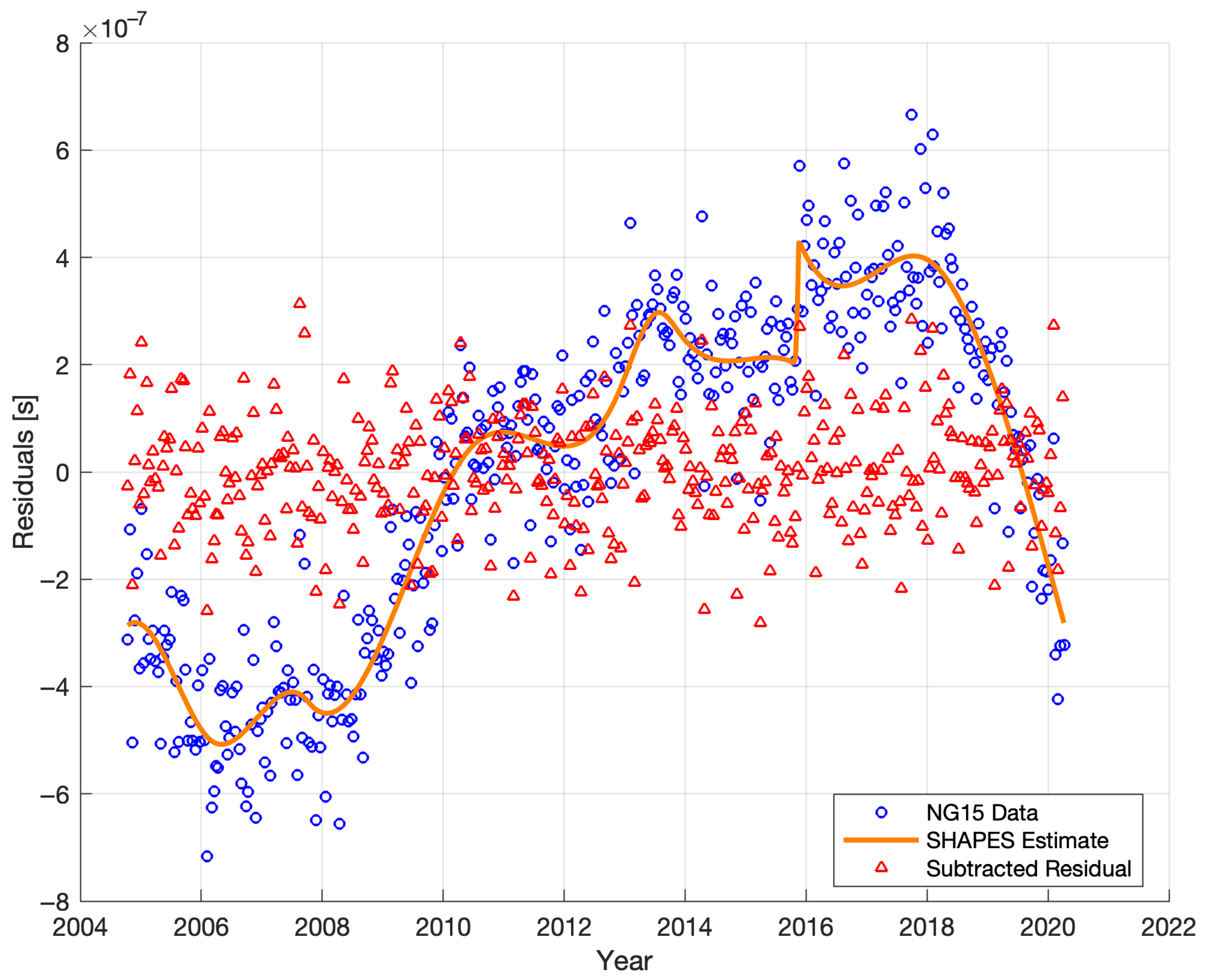
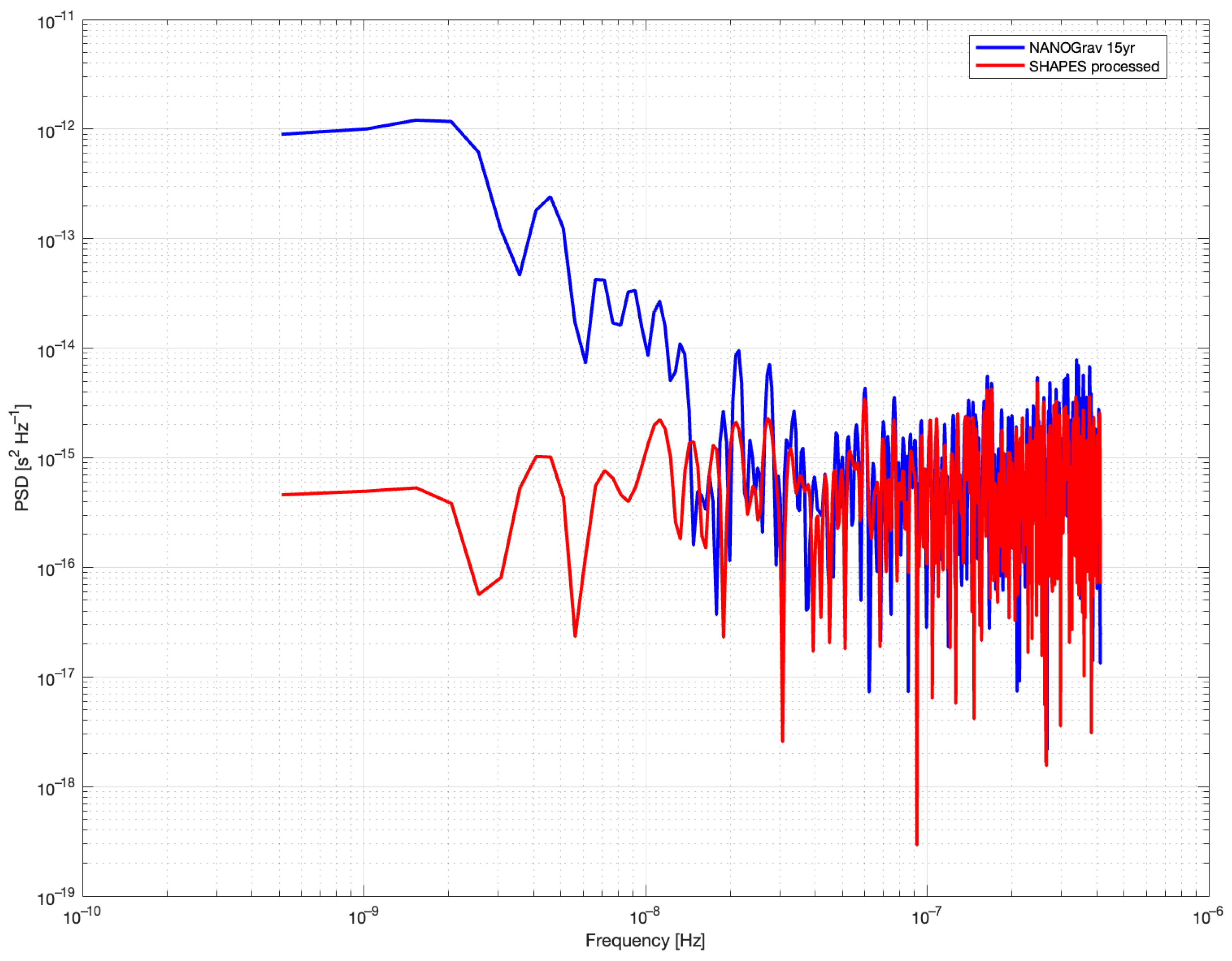
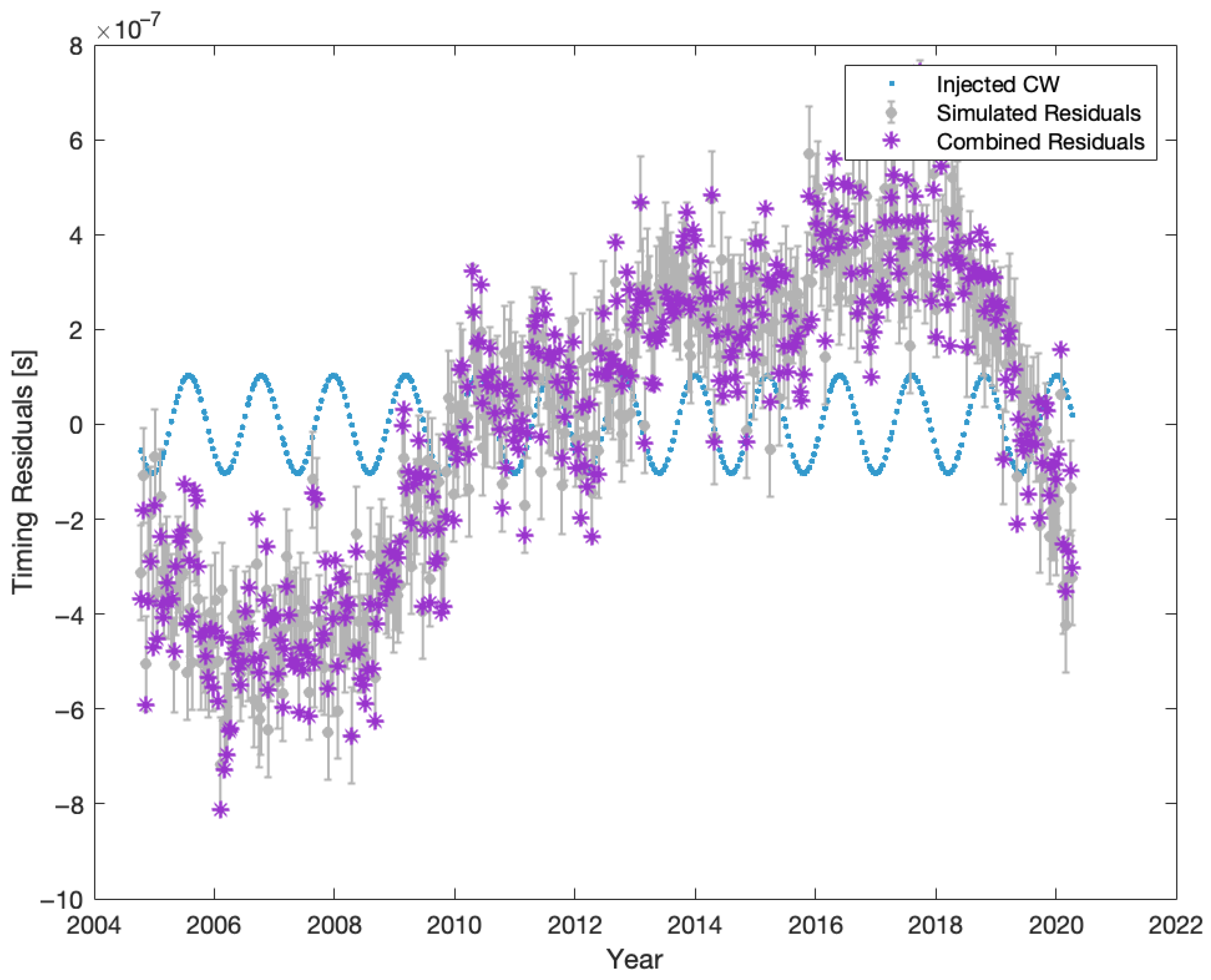
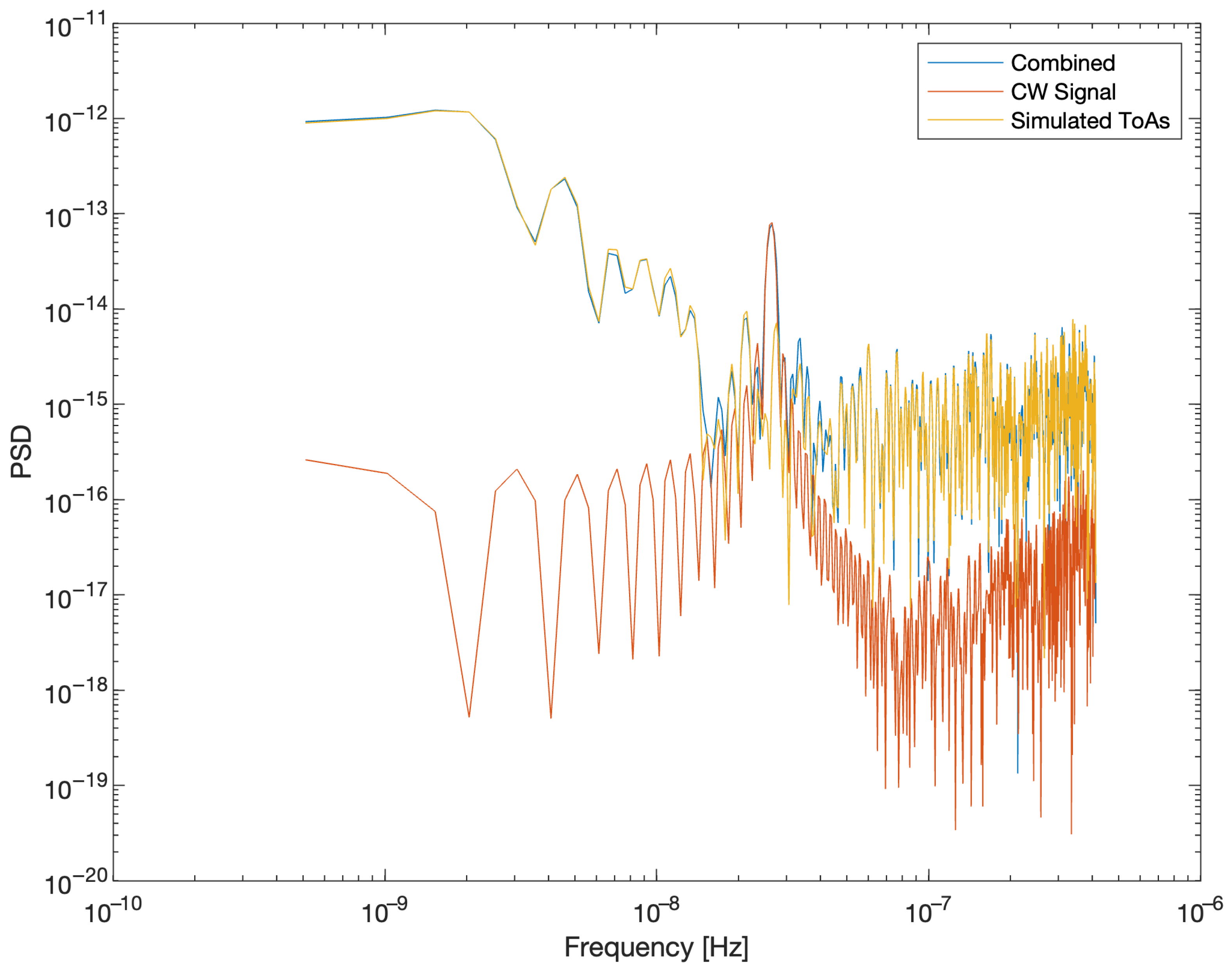
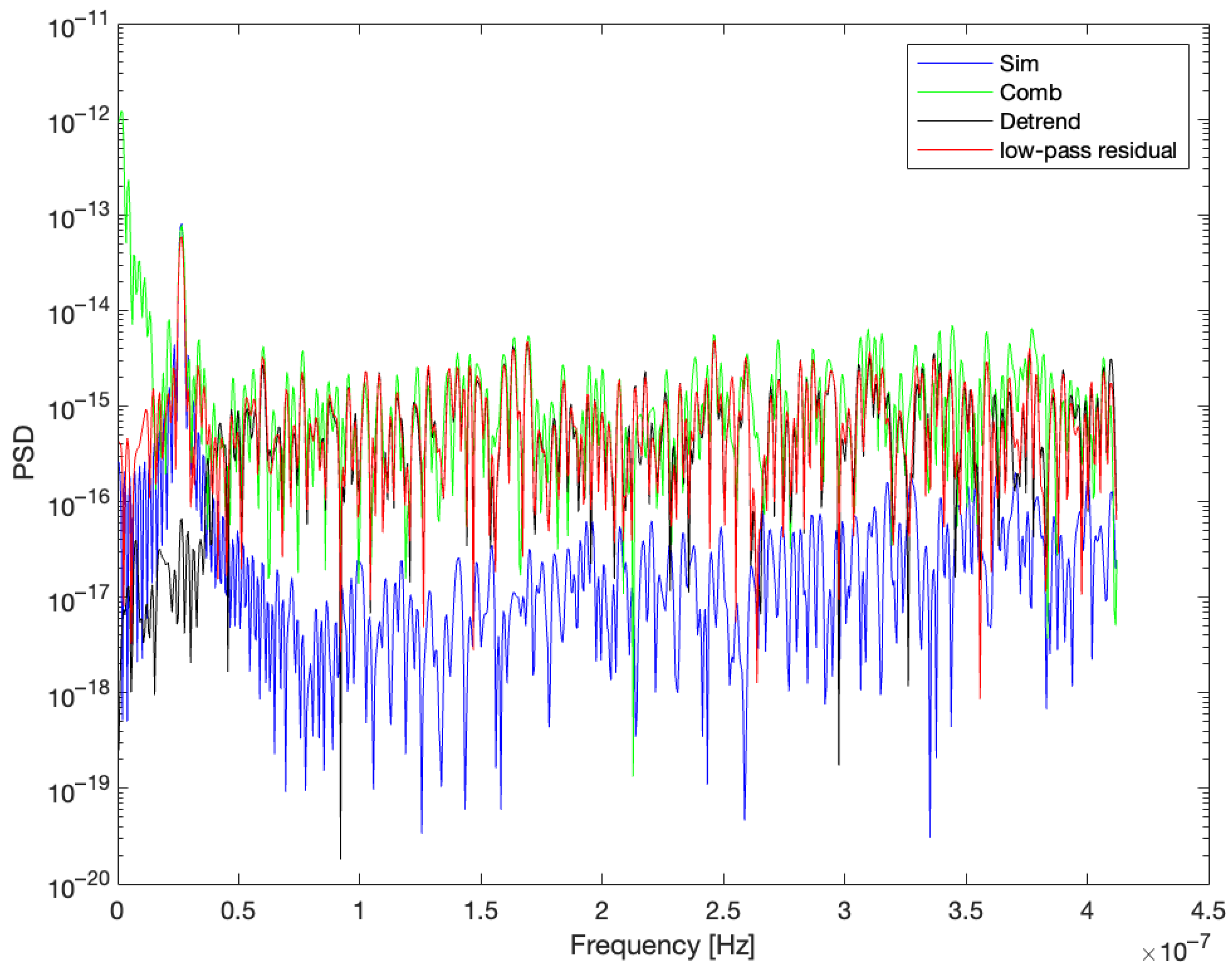
Disclaimer/Publisher’s Note: The statements, opinions and data contained in all publications are solely those of the individual author(s) and contributor(s) and not of MDPI and/or the editor(s). MDPI and/or the editor(s) disclaim responsibility for any injury to people or property resulting from any ideas, methods, instructions or products referred to in the content. |
© 2025 by the authors. Licensee MDPI, Basel, Switzerland. This article is an open access article distributed under the terms and conditions of the Creative Commons Attribution (CC BY) license (https://creativecommons.org/licenses/by/4.0/).
Share and Cite
Qian, Y.-Q.; Wang, Y.; Mohanty, S.D. Red Noise Suppression in Pulsar Timing Array Data Using Adaptive Splines. Universe 2025, 11, 268. https://doi.org/10.3390/universe11080268
Qian Y-Q, Wang Y, Mohanty SD. Red Noise Suppression in Pulsar Timing Array Data Using Adaptive Splines. Universe. 2025; 11(8):268. https://doi.org/10.3390/universe11080268
Chicago/Turabian StyleQian, Yi-Qian, Yan Wang, and Soumya D. Mohanty. 2025. "Red Noise Suppression in Pulsar Timing Array Data Using Adaptive Splines" Universe 11, no. 8: 268. https://doi.org/10.3390/universe11080268
APA StyleQian, Y.-Q., Wang, Y., & Mohanty, S. D. (2025). Red Noise Suppression in Pulsar Timing Array Data Using Adaptive Splines. Universe, 11(8), 268. https://doi.org/10.3390/universe11080268





